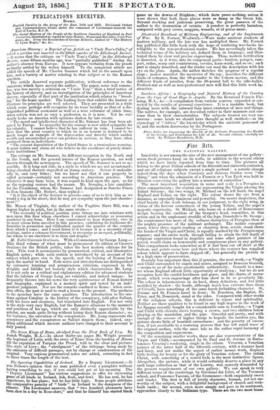lint arts.
THE NATIONAL GALLERY.
Inactivity is not among the sins of the new management of our gallery : seven fresh pictures hang on its walls, in addition to the several others which we have lately reported from time to time. The pictures all belong to the great Italian schools of the fifteenth and sixteenth centuries, and are all religious subjects except a single portrait : a notable change indeed from the days when Carraccis and dubious Guides were "the thing," and when the admission of a Francia or a Van Eyck was held to threaten converting the gallery into a museum of curiosities !
The most important acquisition in name and scale is a Perugino in three compartments ; the central one representing the Virgin adoring the Infant Saviour ; the two wings, St. Michael on the left hand, the angel Raphael and Tobias on the right. The colour draws the eye from a distance, as especially luminous and powerfuL On nearer inspection, the chief beauty of the work belongs, in our judgment, to the right wing, in virtue of the fervent earnestness of the young Tobias, and the angel's majestic superiority. St. Michael, who leans on a shield of Renaissance design bearing the emblem of the Gorgon's head, resembles, in this action and in the unpleasant straddle of the legs, Donatello's St. George : the countenance has more of the softness distinctive of Perugino than of the mighty presence of the militant archangel. The middle compart- ment, where three angels reading or chanting from scrolls stand above the heads of the Virgin and Christ, is equally marked by the Peruginesque manner; and the entire work, though failing to attain the full depth of religious expression found in Angelico and some other painters of his period, would claim an honourable and conspicuous place in any gallery. This compartment looks somewhat as if it had been cut off short at the bottom, and points occur here and there where the restorer has supplied colour which appears to have chipped off; but generally the picture is in a high state of preservation. Scarcely less important than this if genuine, the next work,—a Virgin and Child surrounded by angels and saints, assigned to Benozzo Gozzoli, —seems to us of far more questionable authenticity. Gozzoli is a mas- ter whom England affords little opportunity of studying ; but we do not recognize here the candid loveliness and grace, and the charm of move- ment, which even engravings after him show to be so peculiarly his. The colour is inharmonious in its hard, sharp definition, and but little modified by shadow : the heads, although much less extreme than those of Crivelli, have something of the same harsh forbidding character. St. Jerome and St. Francis kneel in front ; St. Zenobius, the Baptist, St. Peter, and St. Dominick, stand at the sides. Compared with other works of the religious schools, this is deficient in repose and spirituality. Neither are these qualities to be found in any high degree in the work of Lo Spagna recently bought for a considerable sum in London,—a Virgin and Child with cherubs above bearing a crown, and two children below playing on the mandoline and the pipe. Graceful and pretty, and with enough of the manner of higher things to beguile the careless eye, the picture shows little of heartfelt earnestness ; and the poverty of execu- tion, if not ascribable to a restoring process that has left small trace of the original surface, tells the same tale as the rather vapid harmony of the composition and expressions. Of the remaining smaller works, three are also representations of the Virgin and Child,—accompanied by St. Paul and St. Jerome in Barto- lommeo Vivarini's rendering, single in the others. Vivarini, a Venetian painter of the latter half of the fifteenth century, with a manner hard and liney, and not unlike the aspect of earlier mosaic work, displays little feeling for beauty or for the glory of Venetian colour. The infant Christ, with something of a scared look, is the most distinctive figure. Altogether, the picture, while it would certainly deserve a place in any such large collection as that of the Louvre, was scarcely demanded by the present requirements of our own gallery. We can speak in very different terms of the renderings by Girolamo dai Libri, of the Veronese school, and Francesco Tacconi, of the Cremonese--both exquisitely sweet and tender. The first is full of lovely character, human, yet not un- worthy of the subject, with a delightful background of church and rock- built castle ; the second, even more simple and pure in its sentiment, approaches closely to the Bellinian typo. These are the two most beam-
tiful paintings of the Madonna and Child, unaccompanied by other figures, which the gallery possesses.
The portrait is by Bartolommeo Veneziano, of Lodovico Martinengo,- a young man, beardless and patrician, of some twenty-four or twenty- five years of age. It would be difficult to find any portrait more noble in character, or more magnificently grand or gorgeous in colour. The deep red and black of the costume, relieved by white and gold, and the sombre sunken green of the background, constitute a combination of colours severe and superb at the same time, such as Venice alone pos- sessed the secret of; and this masterpiece bespeaks for its producer kin- ship with the greatest of her sons.



























 Previous page
Previous page